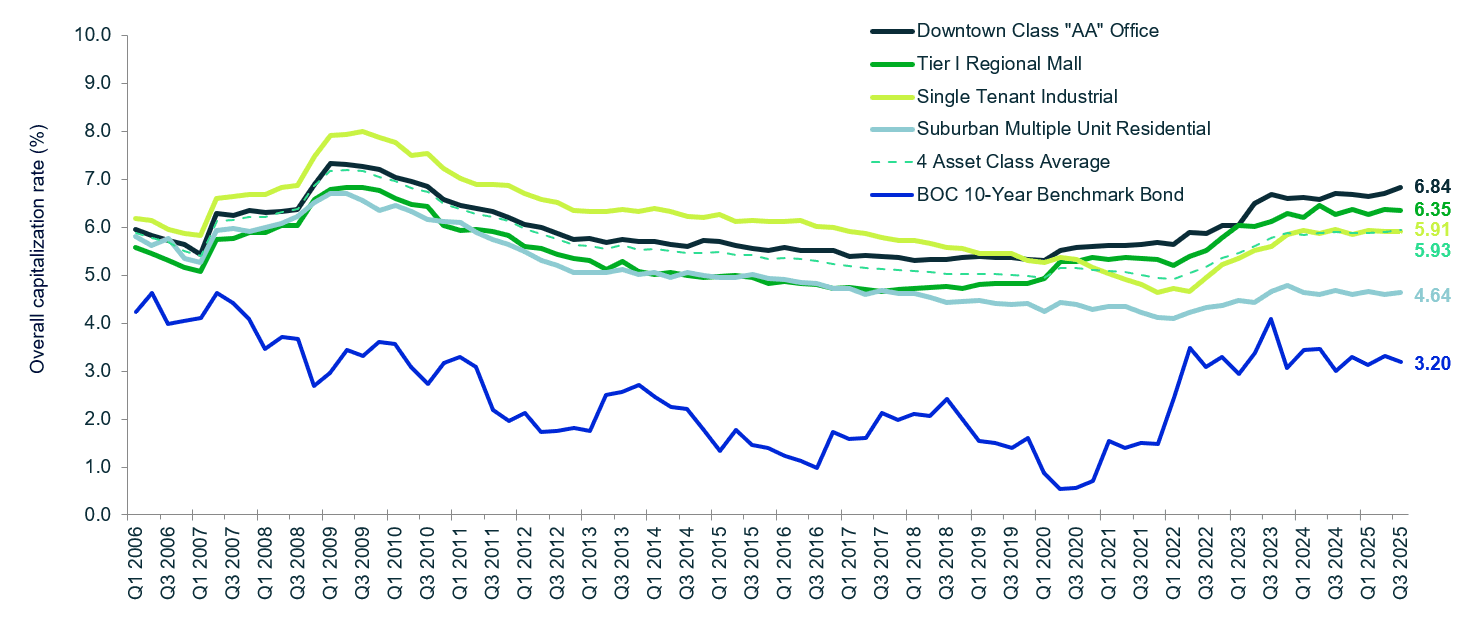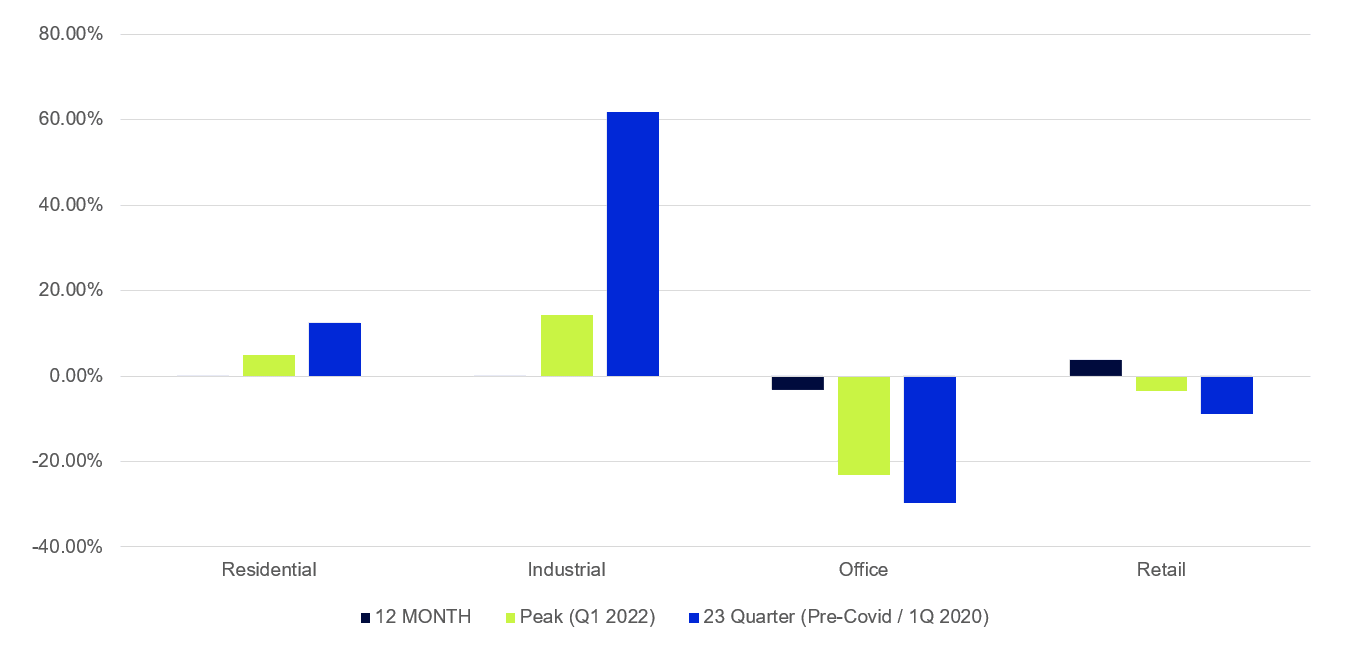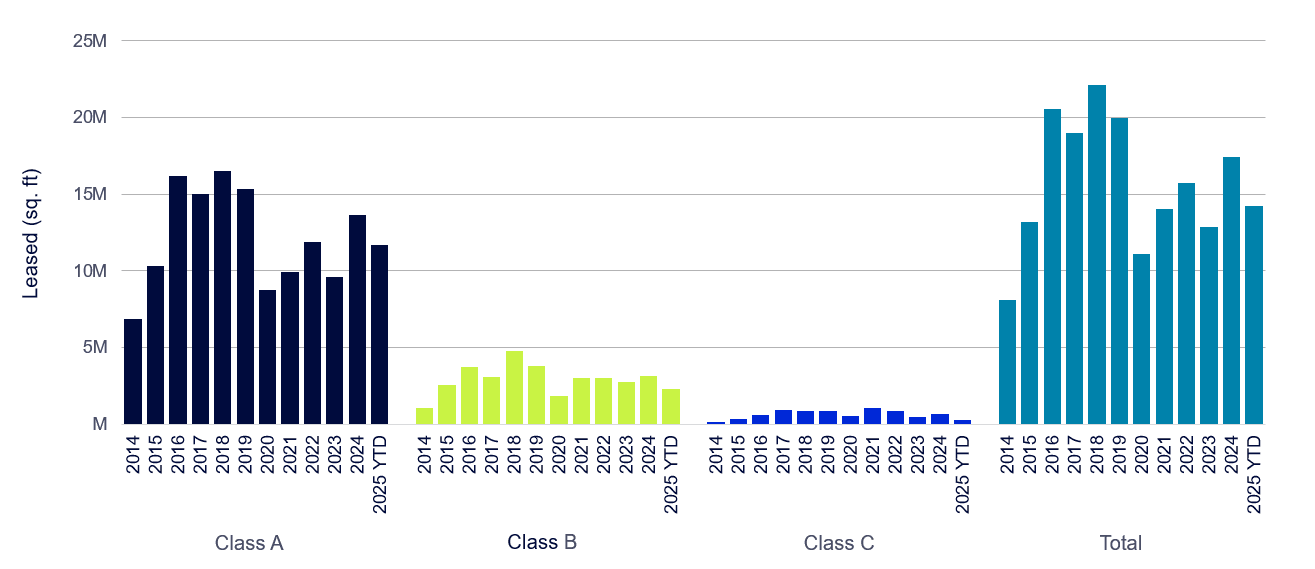Canadian CRE valuation analysis - Q3 2025
Canadian CRE values held steady in Q3 2025 as investors paused amid uncertainty, with stable cap rates and cautious optimism for 2026.

Key highlights
Canadian commercial real estate values dipped by just -0.03% in Q3, a sign that the market is finding its footing despite economic headwinds
With both cash flows and cap rates holding level, valuations are proving resilient, reflecting investor caution rather than distress
Retail reported the highest value gains, with a rise of 0.36%, driven primarily by demand for grocery-anchored centres
Office continued to see values slip, although the decline of -0.26% in Q3 is less extreme than prior quarters
Across all sectors, a slowing development pipeline will help improve the supply-demand imbalance in the medium term
Commercial real estate and multifamily property values remain stable amid market challenges
Real estate values across the four main asset types – office, industrial, retail, and multifamily – saw little quarter-over-quarter change in Q3, dipping a slight 3 basis points.
“Considering the challenges and everything going on in the macro economy, flat is good. Valuations are holding up under market pressures,” says Robert Santilli, Altus Group’s Director of Valuation Advisory, Canada.
The green line in Figure 1 shows the quarterly value change of Altus Group’s valuation dataset. The bars represent the relative contribution to overall change from office, retail, industrial, and retail sectors.
Figure 1 - All assets value change, 2019-2025 year-to-date

Source: Altus Group
Two key factors contributing to stable valuations are a lack of cash flow growth and low transaction volume. A softening economy is weakening demand for space, and in turn, pricing power for landlords. Industrial has the added specter of tariffs that are weighing on leasing activity, which is contributing to new deals being signed at lower effective rates. “All of those factors combined are weighing on cash flow growth,” says Santilli.
Property pricing isn’t moving because of low transaction volume, and those transactions that have occurred are not setting new precedents or suggesting that repricing is necessary. The pace of transactions at roughly $34.56 billion year-to-date, is lagging investment sales volume for the past two years, which reached $55.95 billion in 2023 and $56.59 billion in 2024.
The current outlook from Altus Group is that the Canadian economy is slowing but is likely to avoid a recession. Economists are forecasting that the country’s economic growth will slow in the near term to a rate of 1.2% to 1.3% for 2025. The Bank of Canada cut its key interest rate by 25 basis points to 2.5% in September 2025, citing its reasons for doing so as a weakening economy and softer labour market, despite easing inflationary pressures.
It also is important to note that the economy continues to show weakness compared to six months ago, when news of US tariff policy shocked global markets. Altus Group’s Canadian data shows that transaction activity remains muted, consistent with investors taking a more cautious stance. “Canada has weathered the worst of the storm that occurred during the first half of the year, related to tariffs and trade discussions,” says Ray Wong, Altus Group’s Vice President of Data Solutions. “Cap rates are flat, which reflects the lack of transaction activity, as well as the uncertainty in the marketplace. However, real estate fundamentals remain stable.”
Figure 2 - Cap rates reflect market uncertainty

Source: Altus Group’s Investment Trends Survey
Analyzing CRE valuation trends across property types
Although the headline theme across property sectors is that valuations are holding relatively steady, it remains a bifurcated market. That theme is especially prevalent in retail and office. Strong performance among grocery-anchored centres is helping to lift values in a sector where Class B malls are still struggling. Office continues to see outsized demand for AAA space, which is benefiting Class A more broadly as the availability of premier space shrinks.
Industrial and multifamily are also seeing nuanced performance due to a surplus in new supply that is taking time to absorb. A slowing development pipeline, across all sectors, will contribute to a more favourable supply-demand balance in the medium term.
Retail
Retail remains the front-runner in value gains, with average valuations moving 0.36% higher in Q3. The increase is credited largely to open-air grocery-anchored res, which are generating both higher operating incomes and strong buyer demand. The challenge is that there are few assets for sale. Meanwhile, Class B malls continue to surprise to the downside. “Every time a secondary B mall transacts, it involves a heavily structured deal that sets a new precedent on low value,” says Santilli.
Figure 3 - Sector quarterly value change, retail

Source: Altus Group
Looking ahead, some of the potential headwinds for retail could be stress on the consumer in a weaker economy. Although consumer spending has remained relatively resilient, that’s not the case for all consumers, cautions Santilli. Some of the strength in consumer spending is at the top end of the market, especially among consumers who are benefiting from the wealth effect resulting from the rise in stock market values this year. Lower and middle-income consumers are struggling with inflation and higher food prices, and they may pull back on spending if they’re nervous about losing their jobs, he adds.
People are nervous about the direction of the economy. A poll conducted by Canada Pulse Insights on behalf of CityNews found that 84% of people in the Greater Toronto Area (GTA) have been affected in some way by tariffs. Three-fourths of respondents said tariffs had increased their cost of living, and 28% expressed anxiety over losing their jobs as a result of tariffs. “People are thinking, maybe I should put off this big purchase because of the tariffs or because of uncertainty,” says Wong. “We haven't felt that yet, but it remains to be seen whether we start seeing some of that lag effect, especially if layoffs continue.”
Industrial
Industrial values remained unchanged in the second quarter, and are down just 0.07% year-over-year . “In this case, flat is good, because industrial is seeing more downward pressure on rents,” says Santilli. Values could move lower as the industrial sector navigates a period where fundamentals are softening, which could last for another six to 12 months.
Figure 4 - Sector quarterly value change, industrial

Source: Altus Group
Industrial momentum started to slow in 2024 in the wake of significant new supply. “After five years of record growth, we started to see a pullback in demand in the last 9 months,” says Wong. Slowing demand for space due to tariff concerns and general uncertainty has resulted in higher vacancy and increased concessions from landlords looking to fill space with offers of limited free rent. Some industrial tenants have also downsized and reduced their footprints based on the concerns in the economy and implementing automation in the facilities. Even though Montreal is experiencing some of the biggest challenges with a vacancy rate that has risen to 8.5% compared to 4.9% in Toronto, demand for newer space remains strong.
“Despite near-term challenges, our clients are telling us that their highest conviction sector is industrial, because once you get through this short-term period and find the bottom on rent and vacancy, there will be a rebound,” says Santilli. Broadly speaking, industrial still has relatively low availability rates across Canada, and slower development will help with absorption. In addition, industrial values are still up 60% compared to pre-pandemic levels.
Figure 5 - Canada value change, total 12-month versus peak versus pre-pandemic

Source: Altus Group
Office
Office valuations continue to erode with a further dip of -0.26% in Q3. On a positive note, the declines are less extreme, and leasing activity has picked up. “Leasing activity through the third quarter has already surpassed 2023 levels, and it will be interesting to watch if it also surpasses 2024 levels,” notes Wong. Demand is being driven by financial services, renewed activity in tech, and return-to-office mandates.
Figure 6 - Sector quarterly value change, office

Source: Altus Group
“The office story is the same with a bifurcated market still very evident,” says Santilli. Office is seeing strong leasing for top properties. Vacancies in AAA buildings, especially in Toronto and Vancouver, have dropped below 2%, and tenants are having a more difficult time finding large blocks of contiguous space. As premium space becomes limited, demand is cascading into other Class A buildings. Return to office mandates also are helping to drive leasing activity.
Figure 7 - Class A office continues to dominate leasing activity

Source: Altus Data Studio
Residential
Similar to industrial, residential values were relatively flat in Q3, with a nominal gain of 0.05%. All of the major markets are seeing a return of rent concessions. Rents are going backwards in Toronto and Vancouver, while the rest of the country is seeing slow growth.
Figure 8 - Sector quarterly value change, residential

Source: Altus Group
The softening is somewhat counterintuitive to the housing shortage that has been creating affordability issues across Canada. Part of the issue in rental residential is that there has been a surge in new condo construction in the Toronto market. Condos that are sitting on the market and not selling are pulling some of the demand from the rental market.
Another issue impacting the residential market was the Canadian government’s move to restrict immigration. “Immigration was throttled back by the federal government intentionally to cause prices to come down for affordability reasons,” says Santilli. Bringing back some level of immigration would help support occupancy and rent growth for rental residential. On the positive side, new residential construction has slowed considerably. “So, there will come a period of time, possibly in 2027 or 2028, when there’s constrained supply. But, for now, vacancies across the country have moved higher, which has softened rents,” says Santilli.
The Canadian government is offering incentives for housing developers to address the affordability issue. New supply, especially if lower costs are passed on to consumers, is a positive for affordability.
Property valuation outlook
The Canadian economy is likely to soften further through the fourth quarter, with both inflation and unemployment expected to rise. More layoffs are emerging, particularly in the auto sector and financial services. “Going into next year, we expect to see a little bit more certainty along with better economic indicators, which will result in more transaction activity,” says Wong.
Real estate investors have been taking a wait-and-see approach to new investment decisions until there is more certainty on the impact of tariffs and how trade issues will be resolved. Investors are now preparing to move off the sidelines. “They’re kicking the tires on transactions a little bit more, especially with the core assets, and they're more interested in transacting,” notes Wong.
Another positive is that investors have capital, and they have more money to allocate to real estate because of the denominator effect – higher values in other parts of their portfolio due to gains in the stock market this year. Increased investment sales activity in 2026 will help inform buyers and sellers on current market pricing and narrow the pricing gap. Another big tailwind for the Canadian real estate market will be a lower U.S. federal funds rate. “That should also bring down bond yields, which will have a knock-on effect for Canada as well,” says Santilli.
Want to be notified of our new and relevant CRE content, articles and events?
Disclaimer
This publication has been prepared for general guidance on matters of interest only and does not constitute professional advice or services of Altus Group, its affiliates and its related entities (collectively “Altus Group”). You should not act upon the information contained in this publication without obtaining specific professional advice.
A number of factors may influence the performance of the commercial real estate market, including regulatory conditions and economic factors such as interest rate fluctuations, inflation, changing investor sentiment, and shifts in tenant demand or occupancy trends. We strongly recommend that you consult with a qualified professional to assess how these and other market dynamics may impact your investment strategy, underwriting assumptions, asset valuations, and overall portfolio performance.
No representation or warranty (express or implied) is given as to the accuracy, completeness or reliability of the information contained in this publication, or the suitability of the information for a particular purpose. To the extent permitted by law, Altus Group does not accept or assume any liability, responsibility or duty of care for any consequences of you or anyone else acting, or refraining to act, in reliance on the information contained in this publication or for any decision based on it. The distribution of this publication to you does not create, extend or revive a client relationship between Altus Group and you or any other person or entity. This publication, or any part thereof, may not be reproduced or distributed in any form for any purpose without the express written consent of Altus Group.
Authors

Ray Wong
Vice President, Data Solutions

Robert Santilli
Director, Valuation Advisory - Canada
Authors

Ray Wong
Vice President, Data Solutions

Robert Santilli
Director, Valuation Advisory - Canada
Resources
Latest insights






